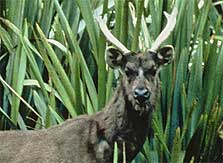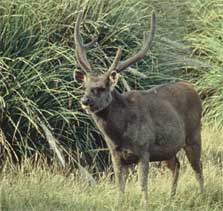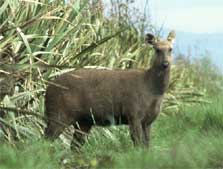
Sambar deer, stag standing among flax
Description
Size: Males average 1370 mm shoulder height and 245 kg in weight with females smaller at 1150 mm shoulder height and weighing up to 157 kg.
Colour: Uniform brown darkening to almost black in older animals with tan to rust red on the rump. Under parts grey to mid brown.
Antlers: Thick, heavily pearled and normally three tined (brow and trez tines and a terminal tine at the end of the main beam). Antlers cast November to December with new ones grown January to March hardening between June and November.
Social behaviour: Males solitary except during the rut. Young males and females form small groups of 2-5 animals. Feed mainly at night and during the day seek shelter in scrub or forest cover. Form complex trail systems accessing feeding areas from day time cover
Reproduction: The rut can happen any time between late May and December with June to August the usual period. The females, attracted by noise and scent, visit the male for a short period until mating takes place. (Harems are not formed.) Males are not particularly vocal during the rut but are known to emit a short harsh belling noise which is rarely heard by hunters.
Gestation period: Approximately 240- 264 days.
Birthing: March-April or July-September.
Nomenclature: Male = stags. Female = hind. Young = fawn/calf.

Sambar stag
Where to hunt
In New Zealand sambar deer are only found in the North Island.
The two main populations of wild sambar deer are found in the Manawatu/Wanganui region and the Bay of Plenty region. Their range in both these areas is mostly on private land – mainly forestry blocks.
Sambar occupy a variety of habitats from indigenous and exotic forests to wetlands and farmland.
Find a hunting block that has sambar deer
You can use the hunting block search function to find hunting areas that have sambar deer.
Search for a hunting block that has sambar deer.
Manawatu
Most of the sambar range in the Manawatu is on private land.
The majority of the herd is on Santoft Forest, owned by Ernslaw One. Permits must be requested from their office in Bulls: Ernslaw One Ltd, 31 Bridge Street, Bulls, Tel: +64 6 322 1558.
Bay of Plenty
Hunters can get a standard hunting permit to hunt sambar where they occur on public conservation land managed by DOC. DOC’s Rotorua and East Coast offices can provide advice.
Access to the DOC areas can be restricted as the main access is through land controlled by Kaingaroa Timberlands and this can be closed due to fire danger or logging activities. Permit information for forestry blocks in this area can be found on the Timberlands website.
Tips for hunting sambar deer
Sambar can be a difficult deer to hunt. As with all hunting the more you can learn about the quarry and the area to be hunted the better the chance of success.
|
Characteristic/behaviour |
Hunting response |
|---|---|
|
Large bodied animals (mature stag 180 – 225 kg and stand nearly 150 cm at the shoulder) |
A rifle calibre with high striking energy is recommended with deer known to have absorbed several shots and still escaped. Suitable calibres include .243, .270, 7mm, 30-06, .308 and .303. |
|
Although tending to be unpredictable, within a hunting area sambar will have preferred spots for feeding, hiding etc. |
Learning as much as you can about the area being hunted will greatly increase the chances of success. |
|
Elusive animals with the ability to exit within close proximity to people without being detected. Often won’t break until a hunter is very close and sometimes crawl rather than run. Can hide in very small patches of vegetation. |
Hunt slowly, stopping often and surveying all around. Don’t discount the smallest of vegetation patches eg small clumps of gorse. |
|
Once spooked sambar usually won’t go far and as retreating can often be heard making a trumpet like noise. |
Listen to retreating animal to gauge where it is heading and after a short time follow. |
|
Sambar feed primarily early morning and late evening utilising the cover of darkness but can be found feeding during the day using vegetation cover. |
Late evening and early morning hunting is likely to find deer out in the open where as day time hunting will likely find deer in amongst thick vegetation. Hunt the change of light on dark nights. |
|
Sambar are attracted to crops for feeding. |
If permission is obtained from the landowner stake out the crop. |
|
Where stock is present in a forest (common management tool for reducing fire danger etc) sambar may feed in amongst them. |
If stock encountered look for any sambar among them (often the one with its head up while the cattle go on grazing) but if shooting be careful of firing zone. |
|
Sambar are very alert to foreign sounds. |
With the wind in the right direction stake out feedings areas and wait for sambar to come to you. |

Sambar deer
Hunting seasons and ballots
In New Zealand there is no seasonal restriction to hunting sambar deer, so generally they can be hunted throughout the year. There are however instances where restrictions apply for specific reasons and periods when hunting is favoured.
Specific restrictions:
- Much of the sambar population in New Zealand occurs on private land and you must get landowner permission to hunt there.
- Forest companies especially will close areas at times of high fire risk.
- Occasionally an area may be closed on a temporary basis to enable research or other management to be undertaken without being compromised by hunting.
It is important to check for these conditions with the DOC office nearest the herd being hunted.
Favoured hunting periods
- The rut is when the stags are endeavouring to attract the attention of hinds and are less cautious than other times. The rut extends over a period from late May to December.
- Spring is another favourable time of the year to hunt sambar deer. During spring sambar can be seen coming out of the forest to feed on new grass and farm crops.
International travel with hunting trophies
You may need CITES documentation to enter or leave New Zealand with your hunting trophy.
Contacts
DOC Customer Service Centre
| Phone: | 0800 275 362 |
| Email: | rotorua@doc.govt.nz |
| Address: | Rotorua Office |
DOC Customer Service Centre
| Phone: | 0800 275 362 |
| Email: | gisborne@doc.govt.nz |
| Address: | Tūranganui-a-Kiwa / Gisborne Office |